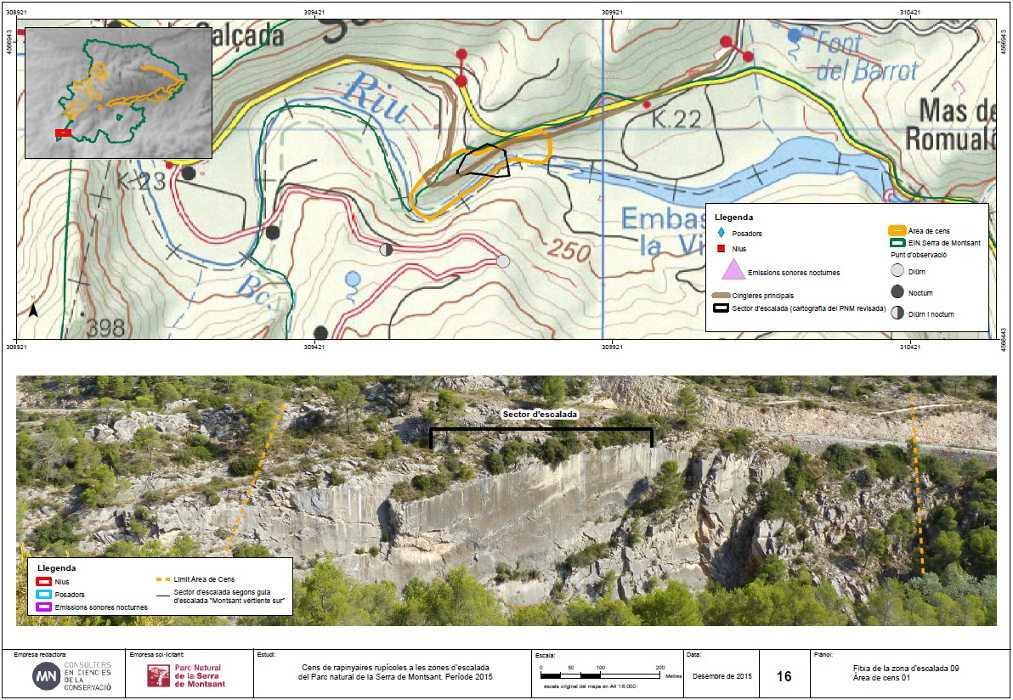MN Actualidad
Census of rupicolous raptors in climbing rocky areas of Montsant Natural Park. 2015 period.
The practice of climbing in either conventional or via ferrata paths can affect geology and wildlife. Concerning the biodiversity, the main impacts may occur on some species of rupicolous flora and fauna.
Since 2006 Montsant Natural Park has a regulation of climbing practices based on both the location of known raptor nesting points and the species that use each of them, which divides climbing zones in free, conditioned or forbidden for these practices.
In order to update the information available in those management areas, and if necessary set changes in the current regulation, MN Consultors performed the 2015 census of the rupicolous raptor species nesting or maintaining active ranges in areas where climbing is allowed.
The study focuses especially on both detection (photo characterization) and mapping areas of primary use, nests and nesting platforms.
The results include the detection of up to eight bird species nesting in the same climbing area, so as the Griffon vulture Gyps fulvus, breeding recently in Priorat, and the Egyptian vulture Neophron percnopterus nesting in the natural park for the first time. They also show an important breeding failure of these scavenging species, while the Peregrine falcon Falco peregrinus or the Common kestrel Falco tinnunculus seem to have fewer problems and show a high breeding success in quite crowded areas. Other breeding species of interest detected in climbing areas are the Black wheatear Oenanthe leucura, the Rock dove Columba livia, the Common raven Corvus corax and the Blue rock thrush Monticola solitarius.
Otras Noticias de MN Actualidad
anterior-
 MN te desea un 2023 lleno de Naturaleza
MN te desea un 2023 lleno de Naturaleza -
 MN Consultores se adhiere al SOC y al Fondo Social Europeo para la contratación de jóvenes en desempleo
MN Consultores se adhiere al SOC y al Fondo Social Europeo para la contratación de jóvenes en desempleo -
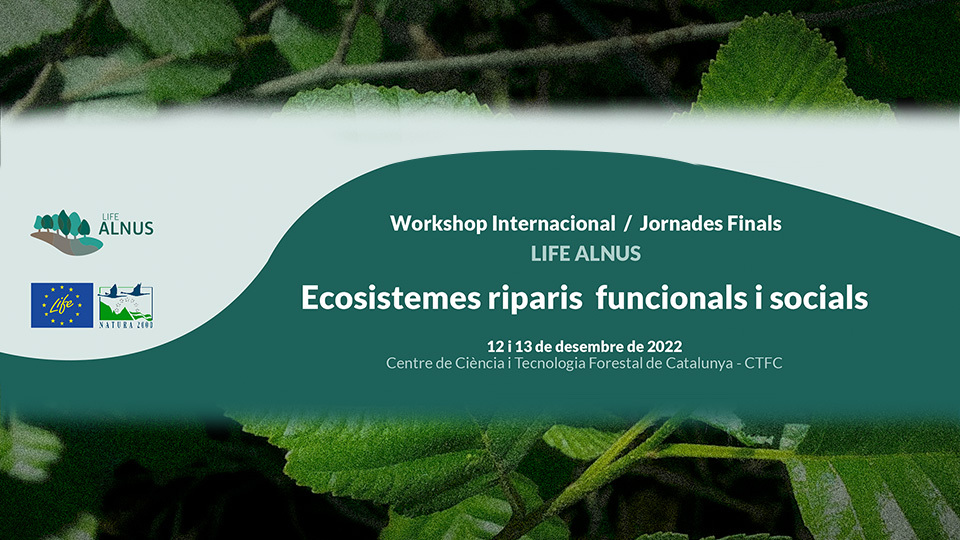 Organizamos el Workshop Internacional “Ecosistemas riparios Funcionales y Sociales” para celebrar la finalización del Life Alnus
Organizamos el Workshop Internacional “Ecosistemas riparios Funcionales y Sociales” para celebrar la finalización del Life Alnus -
 MN ensaya en el Paraje Natural de Poblet metodologías para avanzar en la estrategia de lucha biológica contra el visón americano (Neovison vison) en Cataluña.
MN ensaya en el Paraje Natural de Poblet metodologías para avanzar en la estrategia de lucha biológica contra el visón americano (Neovison vison) en Cataluña. -
 MN te desea un 2022 lleno de Magia
MN te desea un 2022 lleno de Magia -
 MN desarrolla un proyecto para el Parque natural de Montsant de conservación de la fauna del rio Montsant.
MN desarrolla un proyecto para el Parque natural de Montsant de conservación de la fauna del rio Montsant. -
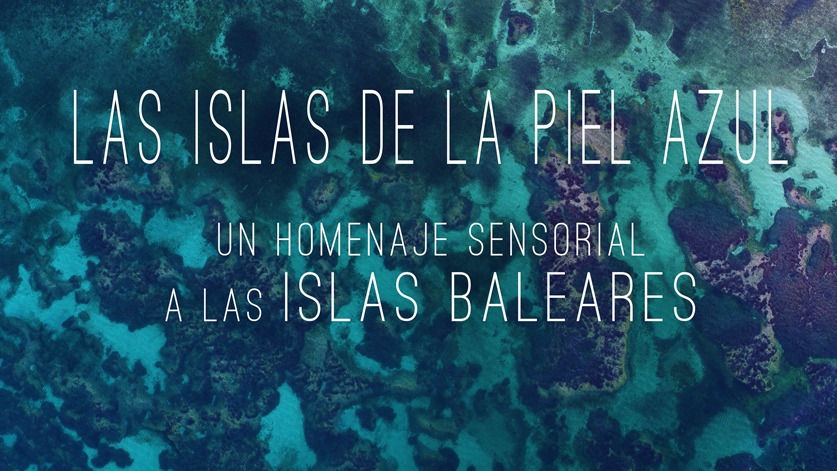 Estreno de “Las Islas de la Piel Azul”, un homenaje sensorial a las Islas Baleares producido por MN Films©
Estreno de “Las Islas de la Piel Azul”, un homenaje sensorial a las Islas Baleares producido por MN Films© -
 MN te desea feliz 2019
MN te desea feliz 2019 -
 Lanzamos el proyecto europeo Life ALNUS
Lanzamos el proyecto europeo Life ALNUS -
 MN diseña la nueva estrategia catalana de restauración de ríos
MN diseña la nueva estrategia catalana de restauración de ríos -
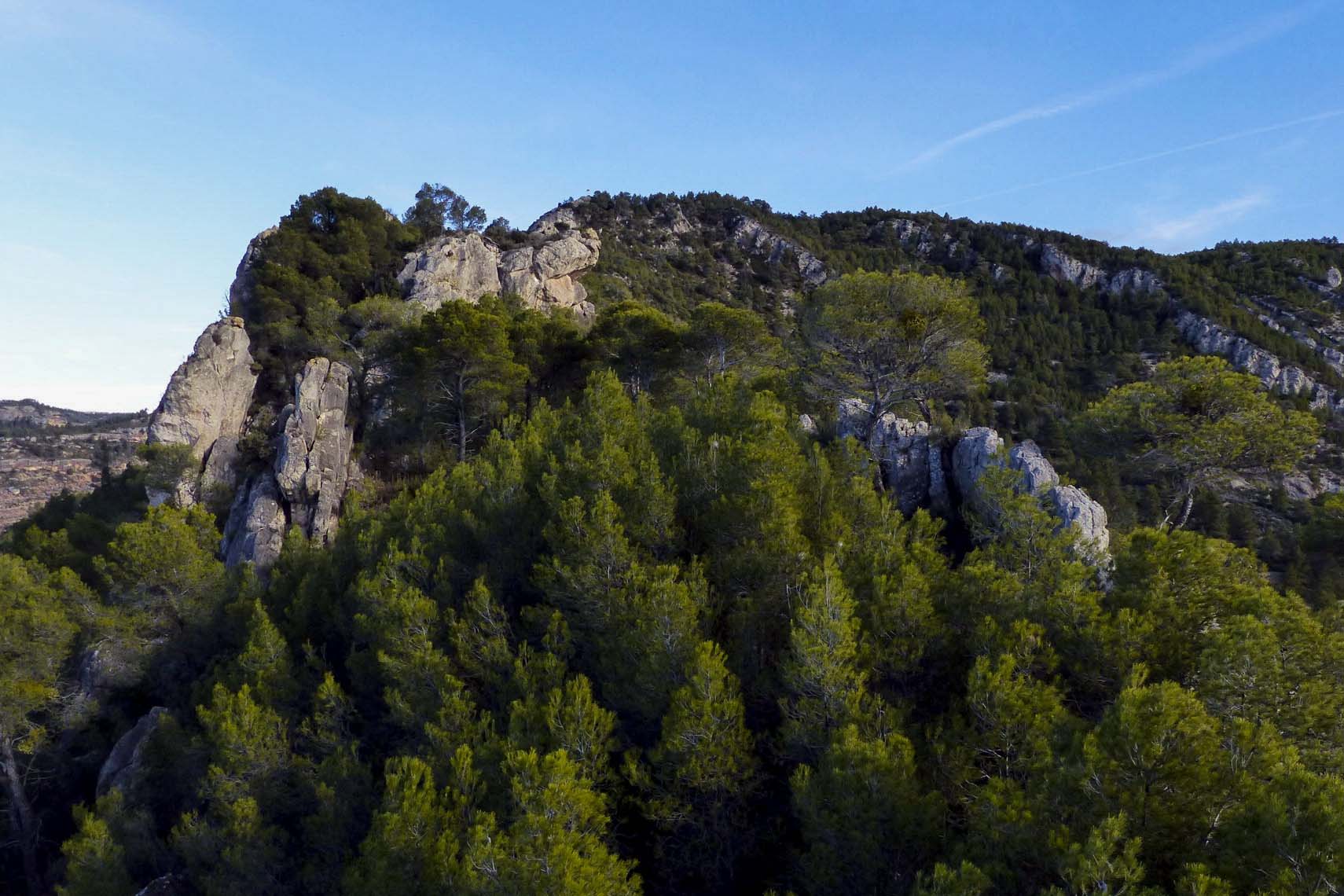 Reencontrada en el Montsant una especie de helecho, después de 85 años
Reencontrada en el Montsant una especie de helecho, después de 85 años -
 Feliz Navidad y prospero 2018. Te deseamos lo mejor.
Feliz Navidad y prospero 2018. Te deseamos lo mejor. -
 MN finaliza su asesoramiento al proyecto europeo LIFE Bonelli presentando una ponencia en su seminario final
MN finaliza su asesoramiento al proyecto europeo LIFE Bonelli presentando una ponencia en su seminario final -
 MN Consultors os desea un feliz 2017
MN Consultors os desea un feliz 2017 -
 MN y Bioscicat coproducen un documental sobre la conservación de las especies biológicas con la participación de la Fundación Eduardo Punset y el Museo de Ciencias Naturales de Barcelona
MN y Bioscicat coproducen un documental sobre la conservación de las especies biológicas con la participación de la Fundación Eduardo Punset y el Museo de Ciencias Naturales de Barcelona -
 MN impulsa el nacimiento de BIOSCICAT, la Sociedad Catalana de Ciencias para la Conservación de la Biodiversidad
MN impulsa el nacimiento de BIOSCICAT, la Sociedad Catalana de Ciencias para la Conservación de la Biodiversidad -
 Concluye la restauración de los ríos Ucero y Abión, en Soria
Concluye la restauración de los ríos Ucero y Abión, en Soria -
 Censo de rapaces rupícolas en las zonas de escalada del parque natural de Montsant. Período 2015.
Censo de rapaces rupícolas en las zonas de escalada del parque natural de Montsant. Período 2015. -
 Curso de vigilancia ambiental y seguimiento de fauna en Parques eólicos
Curso de vigilancia ambiental y seguimiento de fauna en Parques eólicos -
 Proyección del Documental “Sotocontiendas: Dijo el Río” en el Museo de Educación Ambiental de Pamplona en conmemoración del Día Mundial del Agua
Proyección del Documental “Sotocontiendas: Dijo el Río” en el Museo de Educación Ambiental de Pamplona en conmemoración del Día Mundial del Agua -
 Un proyecto diseñado por MN Consultores finalista en los premios RiverPrize, los “Nobel” de la ingeniería fluvial
Un proyecto diseñado por MN Consultores finalista en los premios RiverPrize, los “Nobel” de la ingeniería fluvial -
 Continúa la muerte de águilas perdiceras en Cataluña por causas no naturales
Continúa la muerte de águilas perdiceras en Cataluña por causas no naturales -
 El programa de divulgación científica de Tv3, “QuèQuiCom”, repasa algunos de los proyectos de MN Consultores en la “Serra de Montsant”
El programa de divulgación científica de Tv3, “QuèQuiCom”, repasa algunos de los proyectos de MN Consultores en la “Serra de Montsant” -
 El documental ‘Sotocontiendas -Dijo el Río-’, producido por MN Consultores, clausura el II Congreso Ibérico de Restauración Fluvial
El documental ‘Sotocontiendas -Dijo el Río-’, producido por MN Consultores, clausura el II Congreso Ibérico de Restauración Fluvial -
 MN Consultores en el ‘II Congreso Ibérico de Restauración Fluvial’
MN Consultores en el ‘II Congreso Ibérico de Restauración Fluvial’ -
 MN asesorará durante los próximos 3 años al proyecto europeo 'Life Bonelli'
MN asesorará durante los próximos 3 años al proyecto europeo 'Life Bonelli' -
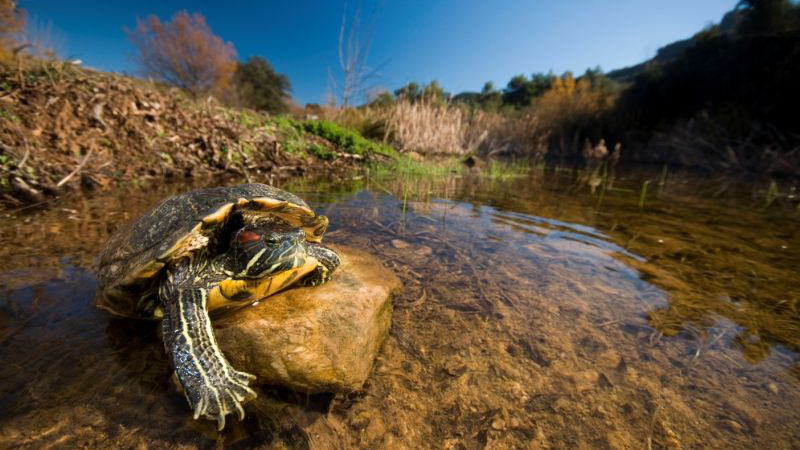 MN impartirá en Navarra un ciclo de conferencias sobre la problemática de las invasiones biológicas de los ecosistemas por parte de especies exóticas
MN impartirá en Navarra un ciclo de conferencias sobre la problemática de las invasiones biológicas de los ecosistemas por parte de especies exóticas -
 Publicados los resultados del seguimiento hidrogeomorfológico, químico y biológico de las zonas húmedas de Cataluña
Publicados los resultados del seguimiento hidrogeomorfológico, químico y biológico de las zonas húmedas de Cataluña -
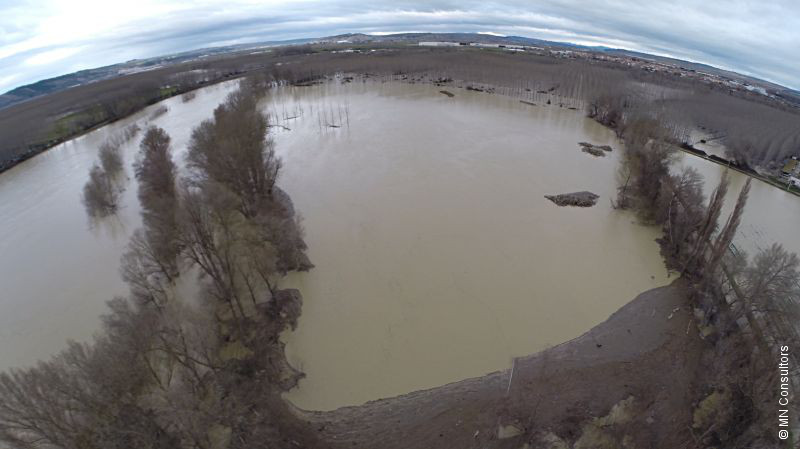 Las recientes inundaciones en la cuenca del Ebro reabren el debate en torno a las políticas de planificación hidrológica [Entrevista a Guillermo García]
Las recientes inundaciones en la cuenca del Ebro reabren el debate en torno a las políticas de planificación hidrológica [Entrevista a Guillermo García] -
 Firmado un convenio para impulsar estudios sobre la biología de 'Lluciapomaresius panteli' y establecer las bases para su conservación
Firmado un convenio para impulsar estudios sobre la biología de 'Lluciapomaresius panteli' y establecer las bases para su conservación -
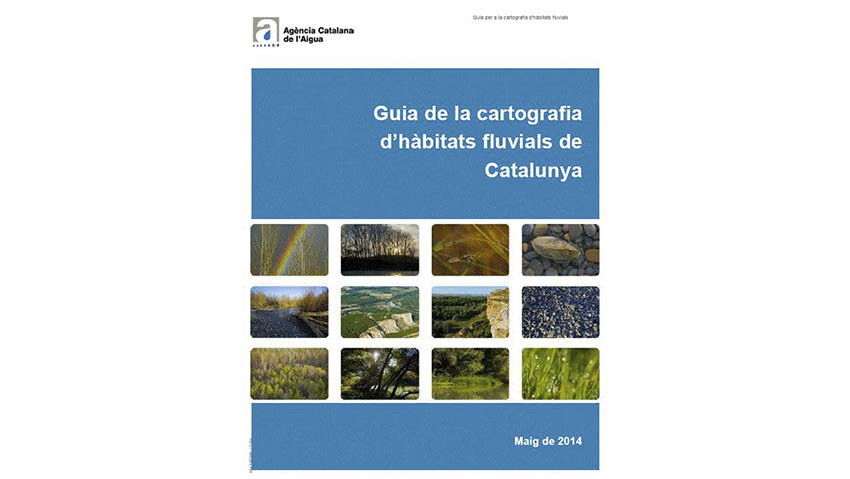 Disponible on line la 'Guía de la Cartografía de Hábitats Fluviales de Cataluña' elaborada por MN Consultores.
Disponible on line la 'Guía de la Cartografía de Hábitats Fluviales de Cataluña' elaborada por MN Consultores. -
 Aportación de MN al seminario internacional 'Territorios Fluviales Europeos'
Aportación de MN al seminario internacional 'Territorios Fluviales Europeos' -
 Aportación de MN a las III Jornadas de Ingeniería del Agua: La protección contra los riesgos hídricos
Aportación de MN a las III Jornadas de Ingeniería del Agua: La protección contra los riesgos hídricos -
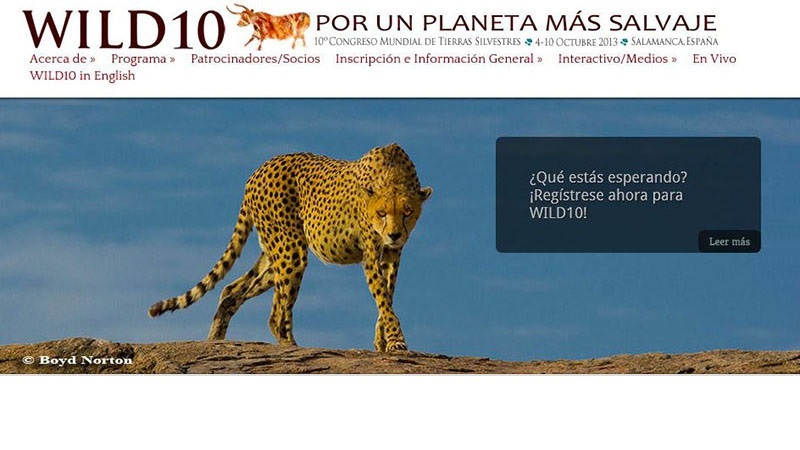 Aportación de Ferran Aguilar, Director de fotografía de MN Consultores, a WILD10 (X World Wilderness Congress)
Aportación de Ferran Aguilar, Director de fotografía de MN Consultores, a WILD10 (X World Wilderness Congress) -
 Finaliza la elaboración del Plan especial del Parque Natural de la Serra de Montsant
Finaliza la elaboración del Plan especial del Parque Natural de la Serra de Montsant






